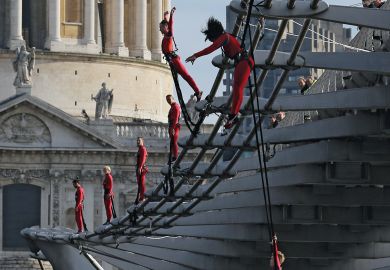One of the most iconic exhibits in the Design Museum’s forthcoming exhibition, Women Fashion Power, is a Mansfield suit worn by Margaret Thatcher. It’s an outfit that typifies her inimitable image. That signature pale blue is not only a reference to her party but also a nod to femininity in an otherwise masculine ensemble. And the severity of the lines is softened by candy stripes at the collar and the cuffs: beneath the Iron Lady, after all, is a modest Grantham housewife busy balancing the budget.
For Thatcher was Prime Minister for most of the 1980s, when ambitious women, à la Joan Collins in Dynasty, would uniformly adopt styles that aped those of powerful men: sharp suits with strict lines, exaggerated shoulders and mannish designs.
But, maintains the exhibition’s co-curator Donna Loveday, modern women no longer have to dress like men to be successful in the workplace. “Today we see the evolution of a new power dress code,” she says. “Professional women are engaging with contemporary fashion as a way to express individuality, a sense of style and project empowerment.”
So among the contemporary women featured in the exhibition are the television presenter Kirsty Wark, pictured in a pretty blouse, and Shami Chakrabarti, director of the human rights campaign group Liberty, in a simple black shirt with trousers – all of them demonstrating that you don’t have to look like a man to compete any more.
But how does that apply to academic women? Unlike other professionals, we never wanted to emulate our male counterparts. How often do you see any woman on campus sporting baggy corduroys or stained T-shirts with Soft Machine logos – let alone the slightly crumpled suits, shiny at the seat, beloved of so many vice-chancellors?
Traditionally, female scholars have chosen outfits that signify that they’re too busy with the occupations of the mind to bother with such trivia as clothes
So, traditionally, female scholars have chosen outfits that signify that they’re too busy with the occupations of the mind to bother with such trivia as clothes. The tired image of flat-heeled blue stockings with messy hair and floppy skirts may just be an out of date caricature. But even so, you could hardly claim that the average senior common room is exactly a hub of chic.
That’s partly because hard-line feminism has always been wary of fashion, regarding it as a sop to the patriarchy. But these days most women who were radicalised in the 1970s have softened their stance. “With the rise of postmodernism,” Julia Twigg points out in Fashion and Age (2013), “feminism has been more willing to acknowledge the inescapability of matters of dress and of the presentation of the body, so that the dream of second-wave feminism of transcending such matters has gone.”
These days academic women have a lot more choice, and more confidence to dress as they wish. But that glorious sartorial freedom starts to be compromised as women move up the ladder to more senior positions. You’re unlikely to meet deans in dungarees or professors in punk. And that’s because by the time they reach those coveted managerial roles women will be, well, older. So if they’re not required to power dress any more, what are the options for ambitious but ageing dons and registrars?
Style pages recently have abounded with advice for the over-40s – most of it drastically unrealistic. “Be a jeans obsessive,” advised Shane Watson in The Sunday Times a couple of weeks ago. “Keep updating. Ask not what style suits you best (answer, bootcut) but what is the shape of the moment and can you get away with it.” I’m not sure how any jeans would go down at academic council, let alone new ones each season.
As for shoes? “If your shoes are bang on trend and awesome, that’s instant anti-ageing points,” Watson assures us. “Safe shoes will make your face look 10 years older, just as risky shoes, providing you can walk in them, keep you looking young and edgy.” Not to mention bandaged and on crutches. Has Watson never heard of weak knees and arthritic toes?
And only a couple of weeks before that, the normally sensible Lisa Armstrong, in The Daily Telegraph, forbade us to wear twinsets. Admittedly there are twinsets and twinsets, and it’s best to avoid the oyster pink crew neck ones favoured by Aunty Dora. But, as any menopausal woman will tell you, a stylish twinset can be her best friend. Layering is the most reliable way to cope with the unexpected hot flush that can overtake you any time – during your inaugural lecture, perhaps, or the presentation of the university budget to the governors.
But while fashion commentators are urging older muttons to dress like lambs, at the other end of the scale Anne Karpf, in How to Age (2014), depressingly advocates sinking into old age rather than delaying or denying it. “Let’s celebrate those women who delight in the freedoms brought by age and give themselves permission to wear elasticated waistbands and sensible shoes, comfort finally triumphing over fashion.”
If you don’t want to give in to the ominous calls of mortality, but instead would like to look chic rather than needy, here’s my own solution: elegant but simple. When I was 18 I read in Cosmopolitan that to be taken seriously at work a woman must always keep on her jacket. And I’ve followed that advice slavishly ever since. For decades I’ve sweltered in meetings, smart jacket defiantly buttoned, while the men lounge round the table in shirtsleeves. No wonder my nickname in learning and teaching committee was “Is It Me” – as in, “Is it hot in here or is it me?”
Register to continue
Why register?
- Registration is free and only takes a moment
- Once registered, you can read 3 articles a month
- Sign up for our newsletter
Subscribe
Or subscribe for unlimited access to:
- Unlimited access to news, views, insights & reviews
- Digital editions
- Digital access to THE’s university and college rankings analysis
Already registered or a current subscriber? Login





